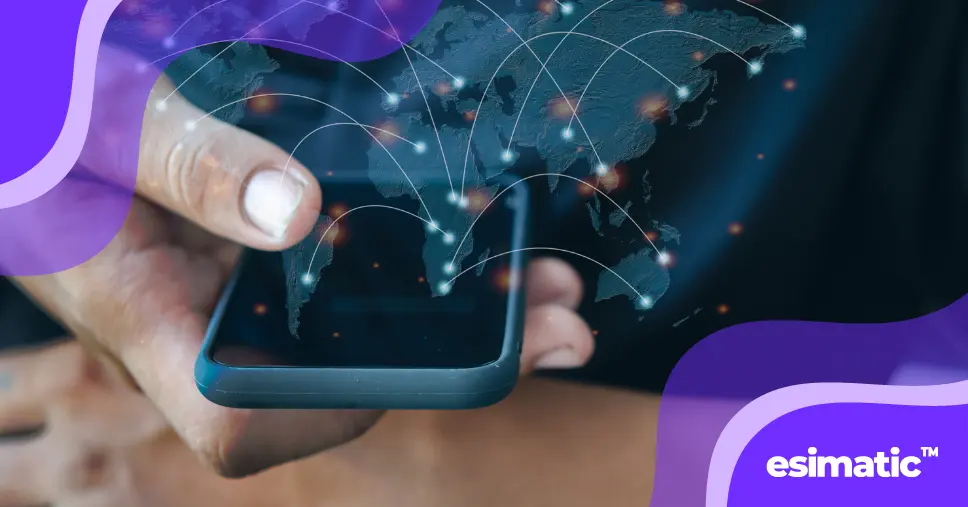Data roaming lets you use mobile internet when you’re travelling outside your network’s coverage area. Like when you’re abroad, it keeps you connected without needing to switch SIM cards or rely only on Wi-Fi. While it sounds handy, it can potentially lead to high charges if you’re not careful. In this article, we’ll explain what is data roaming, how it works, why it can be so expensive, and how to turn it on or off. We’ll also share alternative options, like using an Esimatc eSIM, so you can stay connected without it taking a toll on your budget.
What is Data Roaming – Costs, Alternatives, and How to Turn It Off
7 months ago

What is Data Roaming: How Global Connectivity Works
Data roaming happens when your phone connects to a network outside of your regular mobile provider’s reach. Let’s say you’re using a UK carrier and take a trip to Italy. Your provider may not have its own towers there, but it has agreements with Italian networks. So, when you enable roaming, your phone connects to one of those partner networks automatically – and just like that, you’re back online. It feels seamless. You can scroll, text, call, and post like usual. The only real difference? You’ll notice it once you get your monthly bill.
How Data Roaming Functions: Behind the Scenes of Global Connectivity
Roaming relies on agreements between mobile operators around the world. Since your provider doesn’t own infrastructure in every country, they collaborate with local carriers to share their networks. This is what lets your phone work in places far from home.
Once roaming is switched on, your phone automatically connects to a local partner network when you enter a new country. You might not even notice until you get that “Welcome to Country” text with the data rates attached.
Why is Data Roaming So Expensive: Understanding the Hidden Costs
The convenience of roaming comes at a cost. Without a specific roaming plan, charges can be shockingly high. In some countries, rates can hit €4 or more per megabyte. Yes, per megabyte. That Instagram scroll or map check could easily cost a few euros. To avoid those surprise charges, most networks offer daily or travel passes. But even those can get pricey and not be worth what you get for the price you pay.
Pros & Cons of Data Roaming
Pros
Convenient as you don’t need to swap SIM cards or set things up when you land.
You’re online as soon as you arrive.
Everything works normally, you can call, text, use apps as you usually do.
Cons
Costs are very high and can pile up very quickly.
Limited network choices, as you can only choose from your provider’s partner networks.
It can be a little risky, leaving you exposed to phishing and other cyber threats.
Ways to Turn Off Roaming
If you want to stay on top of things and in control of your data roaming, you can easily disable it in your phone’s settings.
- On iPhone: Go to Settings > Mobile Data > Mobile Data Options and toggle Data Roaming off.
- On Android: Go to Settings > Connections > Mobile Networks and switch off Data Roaming.
This prevents your phone from connecting to foreign networks without your permission.
Better Alternatives to Data Roaming
Data roaming is not the only way to stay connected abroad. There are several alternatives you can consider:
- eSIMs: The easiest and most flexible choice. You can buy and activate a data plan online before or during your trip – no physical SIM card needed. Just scan a QR code and you’re good to go.
- Local SIM cards: If you’re staying somewhere for a while, picking up a prepaid SIM at your destination can give you great local rates.
- Wi-Fi: Free Wi-Fi is everywhere. Hotels, cafés, airports, even public transport. Just be cautious when checking personal accounts or doing anything sensitive.
- Airplane Mode + Wi-Fi: Want to avoid data roaming completely? Turn on airplane mode and use Wi-Fi only. It’s a safe and simple way to stay connected without using mobile data.
Esimatic eSIM the Logical Solution
Data roaming can keep you connected, but often at a steep price and with limited flexibility. Consider trying Esimatic eSIM as a modern alternative. You’ll get reliable data access across 200+ destinations without physically swapping SIM cards. Simply activate your plan digitally and stay connected throughout your journey.
Whether you’re traveling for a weekend or several months, Esimatic offers straightforward pricing without hidden fees or long-term commitments. The Esimatic regional and global plans even let you use a single eSIM across multiple countries.
FAQ
Turn off data roaming, use free Wi-Fi where you can, or try a cost-friendly option like Esimatic eSIM.
Your provider pays foreign networks to let you use their service, and those costs get passed on to you. Without a roaming deal or eSIM, even basic browsing can add up fast.
When you travel, your phone connects to a local network through your provider’s partners. This keeps you online, but it can cost more if you don’t have a roaming plan or an eSIM.
What is the differance between country bundles and regional bundles?
Learn MoreCan I cancel or deactivate my Esimatic eSIM data package at any time?
Learn MoreWhat if I Lose or Damage My Device with an Esimatic Esim?
Learn MoreWhat happens if I exceed the data limit on my Esimatic eSIM data plan?
Learn MoreAre there any hidden fees when buying Esimatic eSIM data plans?
Learn MoreHow do I monitor my eSIM data usage and expiration?
Learn More